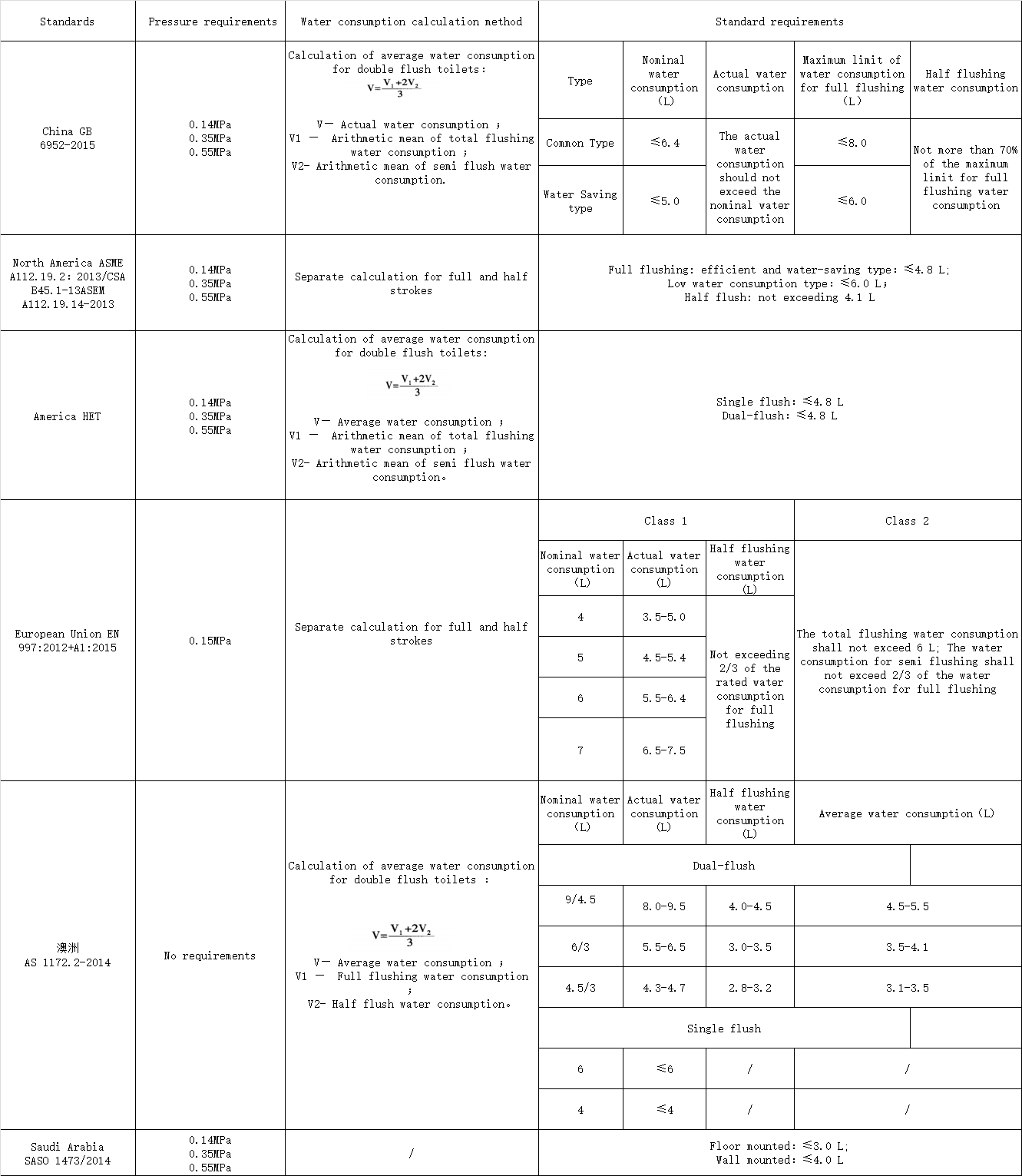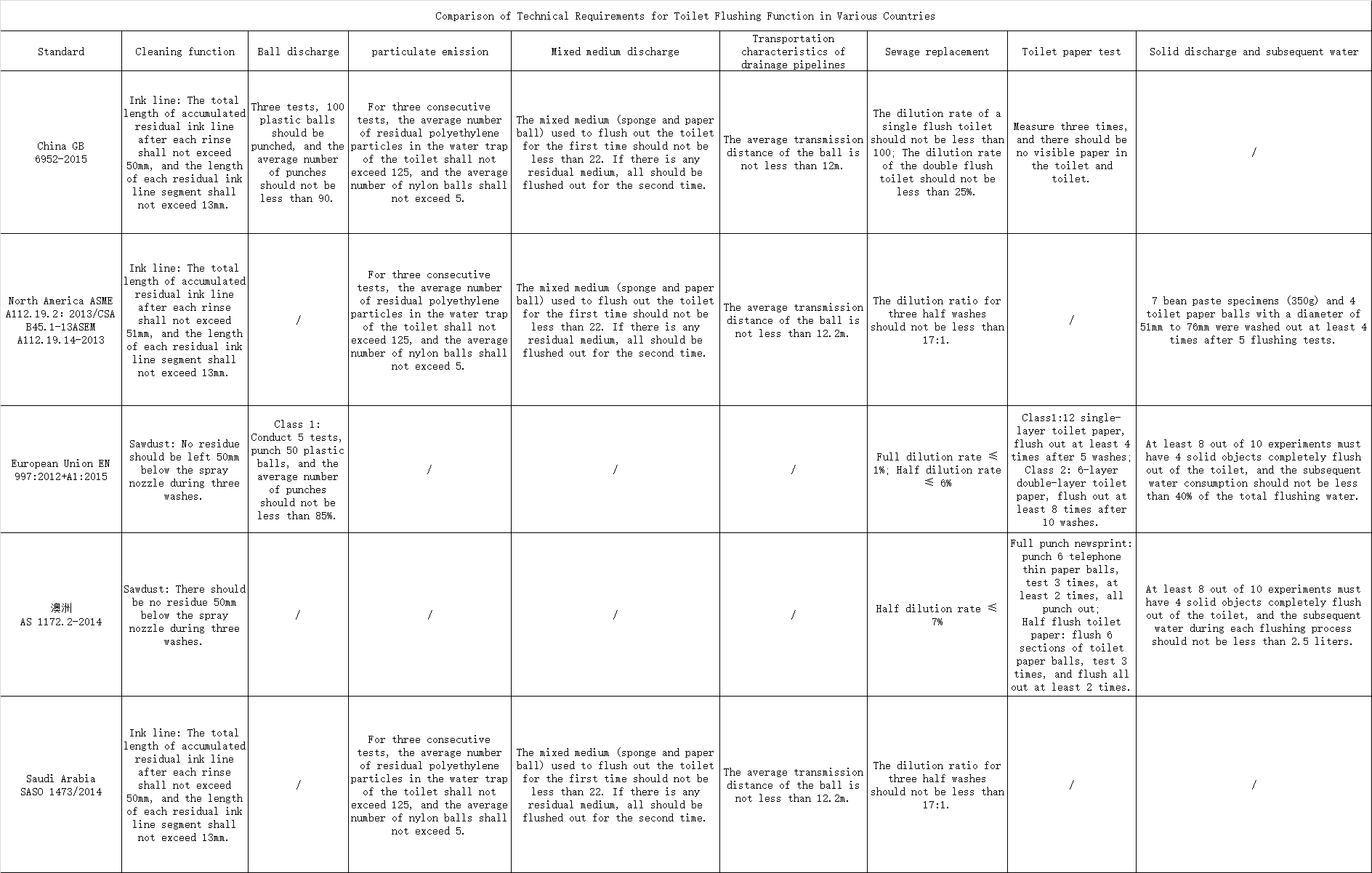Abstract:
This article focuses on the testing methods for water consumption and flushing function of toilet products. By comparing the standards of toilet products in various countries, it is of great significance for Chinese sanitary ware enterprises to better understand the level of foreign toilet product standards and improve the competitiveness of Chinese toilet products in the international market.
Keywords:
Toilet; Water consumption; Flushing function; Testing methods
Part 1
Nowadays, sanitary ware products are regarded as iconic items in modern luxury living.
It has entered every aspect of people’s daily lives.
The styles and types of sanitary ware products are constantly changing, and the quality of product functions is constantly improving.
With the rapid development of China’s foreign trade economy, coupled with the continuous downturn in the international economy in recent years,
foreign merchants pay more attention to quality requirements.
Since 2014, many countries and regions have revised their standards for sanitary ware,
and there have been numerous notifications on technical trade measures and regulations for sanitary ware products.
Taking Saudi Arabia as an example, in April 2014 and March 2016, two draft standards for toilets were issued,
increasing the water consumption and flushing function requirements of toilets.
The technical indicators were too strict and had exceeded the production level of major sanitary ceramic producing countries.
Therefore, timely understanding of changes in relevant national product standards
and accurately testing the water consumption and flushing function of toilets is becoming increasingly important.
How to choose products that are compatible with the inspection standards of the importing countries and
solve technical trade barriers due to the varying requirements of the importing countries.
Reducing unnecessary trade disputes is the fundamental starting point of this study.
The author combines daily tracking and research on foreign technical trade measures and regulations.
Taking the toilet as an example, comparing the water consumption and
flushing function testing methods in the toilet product standards of some countries is of great significance for sanitary ware enterprises to better respond to
technical trade measures in the export trade process.
Part 2 :Differences in product standards for toilets in different countries
2.1 Testing of water consumption
Comparison of technical requirements and testing methods for water consumption of toilets in various countries, such as Table 1.
Table 1 Comparison of Technical Requirements and Testing Methods for Water Consumption of Toilets in Various Countries

2.2 Testing of flushing function
Table 2 Comparison of Technical Requirements for Toilet Flushing Function in Various Countries

2.3 Comparative analysis
(1) According to Table 1, it can be seen that:
1) The pressure conditions for water consumption testing are basically the same in countries and regions such as China,
North America, and Saudi Arabia, while the European Union and Australia have no special regulations on water supply pressure.
The reason is that their standards are applicable to flush toilets. The standard requires that the water supply valve be closed during water consumption testing,
so there is no special regulation on the water supply pressure;
2) In terms of water consumption calculation, China, the United States (HET),
and Australia all use the average of one full flush and several half flush as the water consumption of toilet products,
which is different from the previous practice of only using full flush water as the water consumption of toilet products.
This calculation method requires both full and half flushing to meet the requirements,
and the average value must also meet the requirements. This invisibly increases the requirement for water consumption.
3) The water consumption requirements for toilet products vary from country to country.
The Chinese standard GB6952 divides products into ordinary and water-saving types,
and adds concepts such as nominal water consumption, actual water consumption,
and water consumption limits.
North America and the United States (HET) classify products into high-efficiency water-saving and low water consumption types,
and no longer accept products with water consumption higher than 6L;
Similar to this is the EU standard, which divides products into Class l and Class 2 based on water usage levels.
The Australian standard sets full flush water usage, half flush water usage, and average water usage for double flush toilets,
and the water usage of toilet products must meet the requirements of these three standard values;
Saudi standards are relatively unconventional,
according to the product structure, the water consumption value is specified, and the water consumption requirements are too high,
there are almost no products exported from China that meet the requirements.
(2) According to Table 2, it can be seen that:
1) There are many similarities in the testing standards for the flushing function of toilets in countries such as China,
North America, and Saudi Arabia. In the ball emission testing process, China uses flushing 100 plastic balls, while the EU standard uses flushing 50 plastic balls,
moreover, based on the actual medium comparison, the density of the two plastic balls is different,
the plastic balls used in EU standards are relatively lightweight.
2) There are also differences between EU and Australian standards.
EU standards use flushing balls or flushing solid objects based on product categories,
while Australian standards require that telephone thin paper balls be made using a specialized kneading machine.
The North American standard uses a test specimen made of Douban sauce, requiring the toilet product to flush out 7 pieces totaling 350g, fully simulating human waste discharge;
3) In the sewage replacement test, EU and Australian standards require stricter requirements.
The dilution rate of potassium permanganate or methyl blue solution needs to be calculated using a compact spectrophotometer,
which is more accurate than the method of comparing color differences in Chinese, North American, and Saudi standards to determine whether sewage replacement is qualified.
Part 3 Conclusion
In the current period of sluggish international economic situation,
technological trade measures are emerging one after another,
and the export trade of China’s sanitary ware products faces both difficulties and opportunities.
The author believes that enterprises should maintain close contact with relevant government departments.
By following the relevant information released by research institutions on technical trade measures for ceramic products,
actively participating in the notification and evaluation activities of technical trade measures for ceramic products,
enhancing one’s ability to respond to foreign technical trade measures, understanding the characteristics of domestic and foreign standards,
absorbing and digesting technical trade measures, and strengthening product certification awareness,
Testing products through third-party testing agencies to enhance their competitiveness in the international market.
References
[1] GB6952-2015, Sanitary ceramics [S].
【2】 EN997:2012+A1:2015WC, pans and WC suite with integral Trap [S].
[3] ASMEA112.19.2:2013/CSAB45.1-13, Vitreous China Plumbing Fixtures and Hydraulic Requirements for Water Closure Urinals [S].
[4] ASME A112.19.14-2013, Six liter water closets equipped with a Dual flushing device [S].
【5】 AS1172.1-2014, Water closet partl: Pans [S].
[6] SASO 1474-2014, CERAMIC SANITARY APPLIANCES – WESTERN WATER CLOSETS [S].
【7】 Zhao Jiangwei, Liang Baiqing, et al. Analysis of Trade Barriers for Exporting Chinese Sanitary Ceramics to Europe,Foshan Ceramics (2009): 4-8
【8】 Zhao Jiangwei, Liang Baiqing, et al. Analysis of Trade Barriers in China’s Sanitary Ceramics. Water Consumption of One Toilet Research on testing methods for flushing function [J] Ceramics, 2011 (5): 9-11
About the author: Zhao Jiangwei, engineer, Inspection and Quarantine Comprehensive Technology Center of Foshan Entry-Exit Inspection and Quarantine Bureau,
National Key Laboratory of Building and Sanitary Ceramics Testing: Research direction: Research on foreign technical trade measures.
Zhao Jiangwei, Liu Yamin, Luo Lanhua, Yuan Fangli, Xiao Jinghong, Ma Jin
(Foshan Entry Exit Inspection and Quarantine Bureau, Foshan 528000)